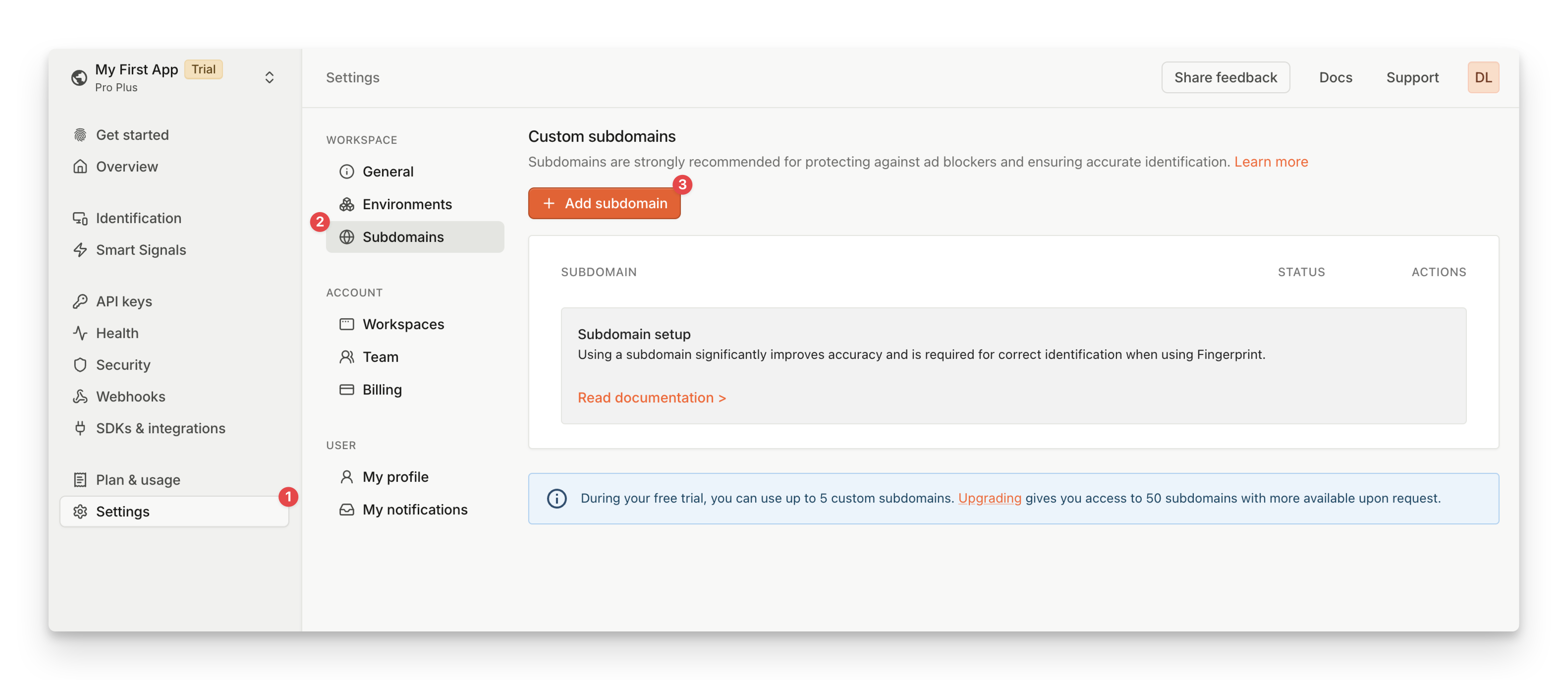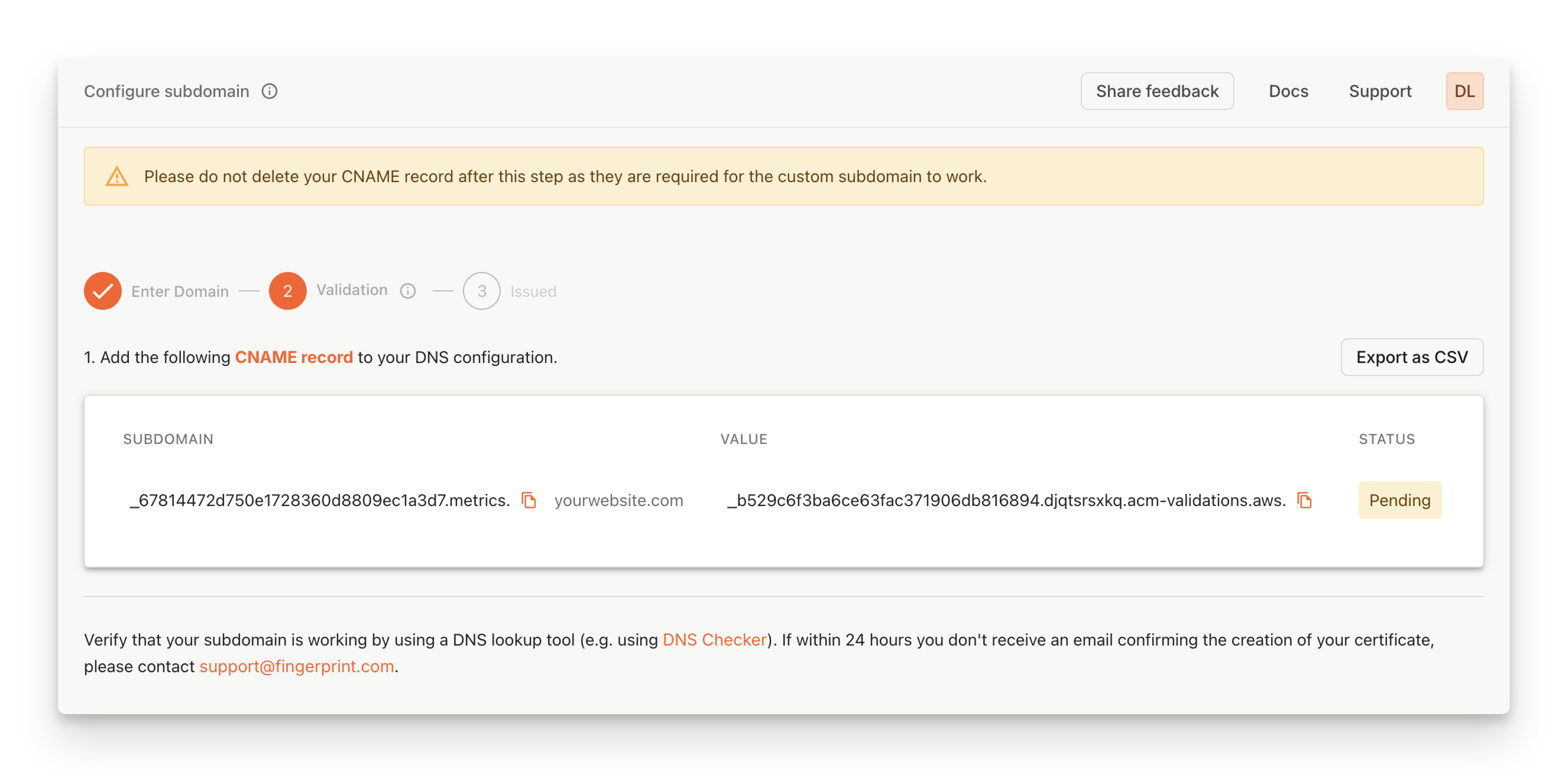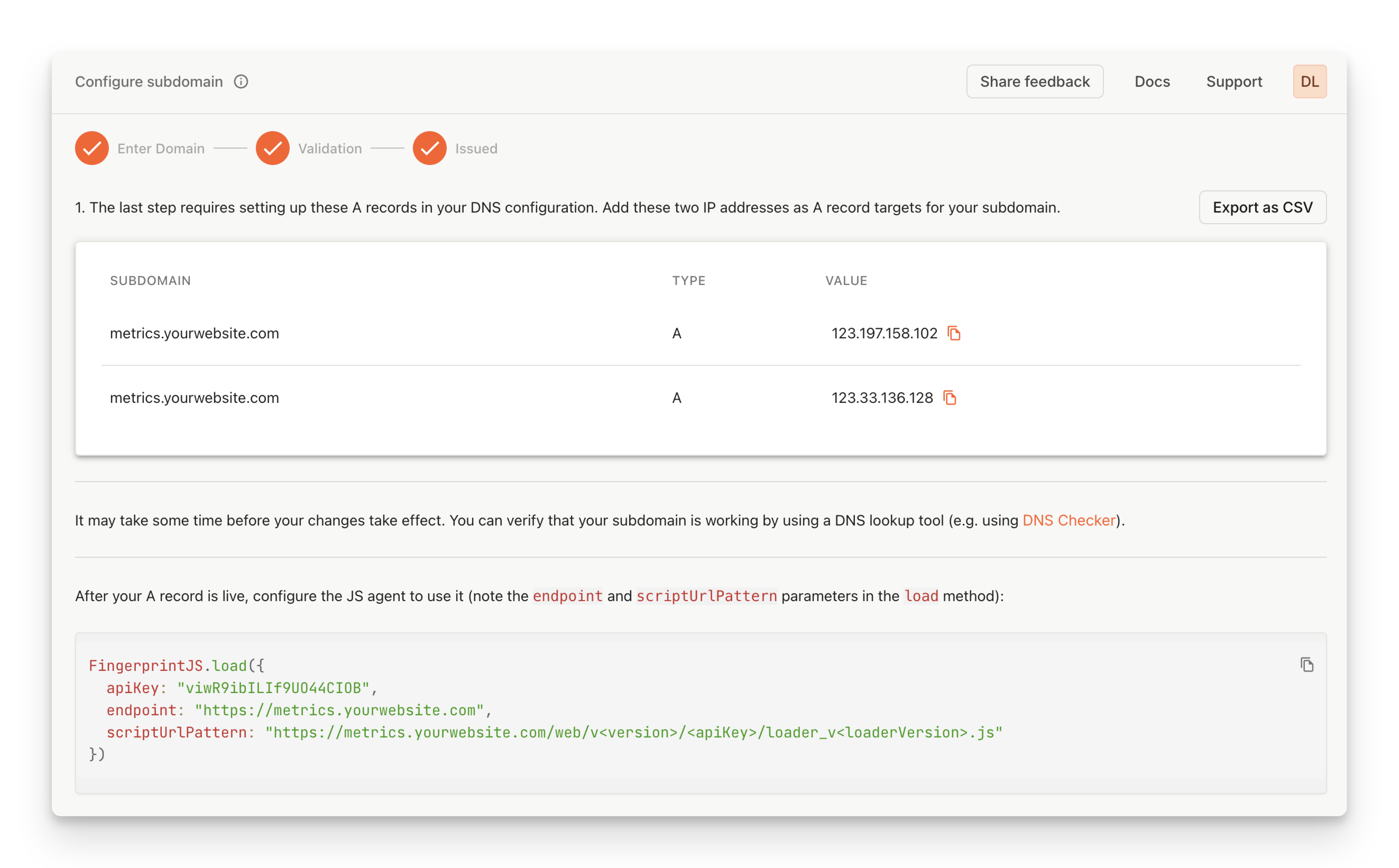Custom subdomain setup
Using a custom subdomain is required for correct identification while using Fingerprint.
The benefits of using a custom subdomain
- Significant increase in accuracy in browsers with strict privacy features such as Safari or Firefox.
- Ad blockers will not block our JS Agent from working. Sending data to an external URL will be stopped by most ad blockers while sending data to an internal URL (like a subdomain) is allowed.
- Cookies are now recognized as “first-party.” This means they can be saved in the visitor's browser and used to reliably identify visitors in situations where third-party cookies are blocked completely (for example, Safari blocks all third-party cookies).
- Fingerprint becomes harder to detect. Requests made directly to our website domain can be easily detected. By routing through a subdomain on your domain, Fingerprint becomes harder for automated blockers and fraudsters to detect.
Limitations of the subdomain integration
- With the release of Safari 16.4, cookie lifetime in Safari are reduced to 7 days when using the custom subdomain setup. We recommend using a cloud proxy integration (e.g. Cloudflare Proxy Integration) to have cookies last up to one year in Safari.
A note on DNS setup:This process requires adding DNS records to your site. Please make sure you have access to your DNS through your DNS provider. Here are some guides to accessing your DNS with some of the most popular hosting sites:
1. Register your custom subdomains
In order to use a custom subdomain, we need to ensure the connection between your site and our server is secure. To do this, we register all subdomains with SSL certificates. Each workspace allows up to 50 unique subdomains. Free trial subscriptions are limited to 5 subdomains. If you need to use Fingerprint on more than 50 domains, please let us know by messaging our support team.
You can begin the setup process by navigating to Settings -> Subdomains and clicking Add subdomain.

Screenshot of the Custom Subdomain setup in the Fingerprint dashboard
Next, you will be able to add your first subdomain. Each subdomain must be added individually, the next 4 steps will be needed for each subdomain added. Please note, after you've successfully added a subdomain, you will not be able to edit it. You can view the DNS details for each domain, but if you need to make changes, you will need to delete your subdomain and add it back.

Screenshot of the Subdomain Addition in the Fingerprint dashboard
When entering a subdomain, remember these guidelines:
- The subdomain should ONLY be used for sending requests to our servers.
- The subdomain’s primary domain should be the same as the request origin (e.g.: “metrics.yourwebsite.com” where “yourwebsite.com” is the website where you want to set up Fingerprint).
- Do not use “fingerprintjs.yourwebsite.com” or “fingerprint.yourwebsite.com” as your subdomain. Instead, use a subdomain like “fp.yourwebsite.com” or “metrics.yourwebsite.com”. This will make it harder for ad blockers to detect and disable the requests.
After you have entered your subdomain, click the submit button to go to the next step.
2. Add CNAME record to verify domain ownership
For Fingerprint to issue a certificate, you need to confirm that you are the subdomain owner by adding a special validating DNS record.
After clicking submit, we provide a CNAME record for your subdomain. When the record is added to your DNS, it will verify your domain ownership and allow the certificate to be issued. Below you can see what our instructions would look like for the example subdomain “metrics.yourwebsite.com”.

Screenshot of CNAME record in the Fingerprint dashboard
At this point, you need to add all the records seen on this page to your website’s DNS. Please allow up to 24 hours for your CNAME records to be validated once they have been added.
You can check the status of your SSL certificate by returning to the customer dashboard. SSL certificates can have one of three statuses:
-
Waiting Validation: At least one of the CNAME records is still “pending”. This can happen if the records haven’t been added yet or were added incorrectly.
To ensure the records are added correctly, you can run this command in the terminal using the host value of the CNAME record:
dig <host> +shortIf the record was added correctly, the CNAME value will be returned.
-
Invalid: The records have been found, but the certificate cannot be issued. This status occurs when a conflicting CAA record registered to the domain does not allow our SSL provider (AWS) to issue certificates.
Fix this status by first adding the following CAA record to your DNS (replace <metrics.yourwebsite.com> with your subdomain):
<metrics.yourwebsite.com>. CAA 0 issue "pki.goog"Once the CAA record propagates, return to the Fingerprint Dashboard, delete the
Invalidcertificate, and repeat step 1. -
Issued: The CNAME was added correctly and the certificate has been issued. When your certificate is issued you will receive an email prompting you to return to the dashboard to complete your subdomain setup.
Note:Using Cloudflare as your DNS provider?
- Make sure to disable DNS Proxying for all records associated with your subdomain.
- Be aware that Cloudflare sometimes adds CAA records that are not visible in the DNS panel. To see these records, you can run the command below (just replace <yourwebsite.com> with your domain):
$ dig caa <yourwebsite.com>
- Cloudflare has a feature called CNAME flattening that can prevent CNAME validation from functioning properly, please ensure this is disabled if you experience validation issues while using Cloudflare DNS.
3. Add an A record for each subdomain
Once your certificate has been issued, an email will be sent with a link that will bring you to the next step of the setup.

Screenshot of a completed custom subdomain creation process
Please navigate again to your DNS provider and enter the A records provided in the customer dashboard.
Your subdomain has two corresponding A records. While only one is necessary to make the connection, we recommend adding both records to ensure coverage if one is temporarily unavailable.
Note:Some DNS providers (like Route 53) allow you to add one record with two IP address values, while others will only allow one A record per IP address.
4. Configuring the JavaScript Agent
Once the A records have been added, update the JavaScript agent configuration.
- Update the
endpointproperty. - Update the URL pattern used to download the agent (
scriptUrlPatternfor NPM packages or theimportURL when using the CDN directly).
Use defaultScriptUrlPattern and defaultEndpoint as fallbacks. The JavaScript agent will continue working even if your custom subdomain becomes unavailable.
<script>
// Initialize the agent at application startup:
// The JS agent will now download from your new subdomain
const fpPromise = import('https://metrics.yourwebsite.com/web/v3/<<browserToken>>')
.then(FingerprintJS => FingerprintJS.load({
endpoint: [
'https://metrics.yourwebsite.com',
FingerprintJS.defaultEndpoint, // The default endpoint as fallback
]
}));
// When you need the visitor identifier:
fpPromise
.then(fp => fp.get())
.then(result => console.log(result.visitorId));
</script>import FingerprintJS from '@fingerprintjs/fingerprintjs-pro'
// Initialize the agent at application startup:
const fpPromise = FingerprintJS.load({
apiKey: '<<browserToken>>',
scriptUrlPattern: [
// Leave the path as show here, only replace the domain
// All the parameters like <apiKey> are filled automatically by the package
// https://dev.fingerprint.com/reference/js-agent-load-function#scripturlpattern
'https://metrics.yourwebsite.com/web/v<version>/<apiKey>/loader_v<loaderVersion>.js',
FingerprintJS.defaultScriptUrlPattern, // Use the default endpoint as fallback
],
endpoint: [
'https://metrics.yourwebsite.com',
FingerprintJS.defaultEndpoint, // The default endpoint as fallback
]
})
// When you need the visitor identifier:
fpPromise
.then(fp => fp.get())
.then(result => console.log(result.visitorId))This code snippet is also available on the final page of the subdomain setup (beneath the A records) and will include your custom subdomain for easy access.
Notes:
- The endpoint subdomain should match the domain of the website.
- If you use a Content Security Policy on your website, don't forget to add the custom subdomain to the
connect-srcdirective of your policy. See the CSP guide for more details.- If you've issued a wildcard SSL certificate in Step 1, you'll see the asterisk in the URL, e.g.
*.yourwebsite.com; replace the asterisk with the actual subdomain you're planning to use, e.g.metrics.yourwebsite.com
Frequently asked questions
I completed the setup. How can I add more subdomains?
If you need to add more subdomains, you can add them individually:
- Navigate to Settings > Subdomains, then click the "Add Subdomain".
- Repeat the entire Custom Subdomain setup outlined in this guide for each new subdomain.
- You can add subdomains at any time by following the steps above.
Each workspace allows up to 50 unique subdomains. Free trial subscriptions are limited to 5 subdomains. If you need to use Fingerprint on more than 50 domains, check out our Cloudflare proxy integration for easier management. Additional certificates can be also requested by messaging our support team.
Updated 11 days ago
